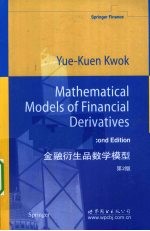图书介绍
金融衍生品数学模型 英文 原书第2版PDF|Epub|txt|kindle电子书版本网盘下载

- 郭宇权著 著
- 出版社: 北京:世界图书北京出版公司
- ISBN:9787510005503
- 出版时间:2010
- 标注页数:530页
- 文件大小:18MB
- 文件页数:546页
- 主题词:金融市场-数学模型-英文
PDF下载
下载说明
金融衍生品数学模型 英文 原书第2版PDF格式电子书版下载
下载的文件为RAR压缩包。需要使用解压软件进行解压得到PDF格式图书。建议使用BT下载工具Free Download Manager进行下载,简称FDM(免费,没有广告,支持多平台)。本站资源全部打包为BT种子。所以需要使用专业的BT下载软件进行下载。如BitComet qBittorrent uTorrent等BT下载工具。迅雷目前由于本站不是热门资源。不推荐使用!后期资源热门了。安装了迅雷也可以迅雷进行下载!
(文件页数 要大于 标注页数,上中下等多册电子书除外)
注意:本站所有压缩包均有解压码: 点击下载压缩包解压工具
图书目录
1 Introduction to Derivative Instruments1
1.1 Financial Options and Their Trading Strategies2
1.1.1 Trading Strategies Involving Options5
1.2 Rational Boundaries for Option Values10
1.2.1 Effects of Dividend Payments16
1.2.2 Put-Call Parity Relations18
1.2.3 Foreign Currency Options19
1.3 Forward and Futures Contracts21
1.3.1 Values and Prices of Forward Contracts21
1.3.2 Relation between Forward and Futures Prices24
1.4 Swap Contracts25
1.4.1 Interest Rate Swaps26
1.4.2 Currency Swaps28
1.5 Problems29
2 Financial Economics and Stochastic Calculus35
2.1 Single Period Securities Models36
2.1.1 Dominant Trading Strategies and Linear Pricing Measures37
2.1.2 Arbitrage Opportunities and Risk Neutral Probability Measures43
2.1.3 Valuation of Contingent Claims48
2.1.4 Principles of Binomial Option Pricing Model52
2.2 Filtrations,Martingales and Multiperiod Models55
2.2.1 Information Structures and Filtrations56
2.2.2 Conditional Expectations and Martingales58
2.2.3 Stopping Times and Stopped Processes62
2.2.4 Multiperiod Securities Models64
2.2.5 Multiperiod Binomial Models69
2.3 Asset Price Dynamics and Stochastic Processes72
2.3.1 Random Walk Models73
2.3.2 Brownian Processes76
2.4 Stochastic Calculus:Ito's Lemma and Girsanov's Theorem79
2.4.1 Stochastic Integrals79
2.4.2 Ito's Lemma and Stochastic Differentials82
2.4.3 Ito's Processes and Feynman-Kac Representation Formula85
2.4.4 Change of Measure:Radon-Nikodym Derivative and Girsanov's Theorem87
2.5 Problems89
3 Option Pricing Models:Black-Scholes-Merton Formulation99
3.1 Black-Scholes-Merton Formulation101
3.1.1 Riskless Hedging Principle101
3.1.2 Dynamic Replication Strategy104
3.1.3 Risk Neutrality Argument106
3.2 Martingale Pricing Theory108
3.2.1 Equivalent Martingale Mensure and Risk Neutral Valuation109
3.2.2 Black-Scholes Model Revisited112
3.3 Black-Scholes Pricing Formulas and Their Properties114
3.3.1 Pricing Formulas for European Options115
3.3.2 Comparative Statics121
3.4 Extended Option Pricing Models127
3.4.1 Options on a Dividend-Paying Asset127
3.4.2 Futures Options132
3.4.3 Chooser Options135
3.4.4 Compound Options136
3.4.5 Merton's Model of Risky Debts139
3.4.6 Exchange Options142
3.4.7 Equity Options with Exchange Rate Risk Exposure144
3.5 Beyond the Black-Scholes Pricing Framework147
3.5.1 Transaction Costs Models149
3.5.2 Jump-Diffusion Models151
3.5.3 Implied and Local Volatilities153
3.5.4 Stochastic Volatility Models159
3.6 Problems164
4 Path Dependent Options181
4.1 Barrier Options182
4.1.1 European Down-and-Out Call Options183
4.1.2 Transition Density Function and First Passage Time Density188
4.1.3 Options with Double Barriers195
4.1.4 Discretely Monitored Barrier Options201
4.2 Lookback Options201
4.2.1 European Fixed Strike Lookback Options203
4.2.2 European Floating Strike Lookback Options205
4.2.3 More Exotic Forms ofEuropean Lookback Options207
4.2.4 Differential Equation Formulation209
4.2.5 Discretely Monitored Lookback Options211
4.3 Asian Options212
4.3.1 Partial Differential Equation Formulation213
4.3.2 Continuously Monitored Geometric Averaging Options214
4.3.3 Continuously Monitored Arithmetic Averaging Options217
4.3.4 Put-Call Parity and Fixed-Floating Symmetry Relations219
4.3.5 Fixed Strike Options with Discrete Geometric Averaging222
4.3.6 Fixed Strike Options with Discrete Arithmetic Averaging225
4.4 Problems230
5 American Options251
5.1 Characterization of the Optimal Exercise Boundaries253
5.1.1 American Options on an Asset Paying Dividend Yield253
5.1.2 Smooth Pasting Condition255
5.1.3 Optimal Exercise Boundary for an American Call256
5.1.4 Put-Call Symmetry Relations260
5.1.5 American Call Options on an Asset Paying Single Dividend263
5.1.6 One-Dividend and Multidividend American Put Options267
5.2 Pricing Formulations of American Option Pricing Models270
5.2.1 Linear Complementarity Formulation270
5.2.2 Optimal Stopping Problem272
5.2.3 Integral Representation of the Early Exercise Premium274
5.2.4 American Barrier Options278
5.2.5 American Lookback Options280
5.3 Analytic Approximatiou Methods282
5.3.1 Compound Option Approximation Method283
5.3.2 Numerical Solution of the Integral Equation284
5.3.3 Quadratic Approximation Method287
5.4 Options with Voluntary Reset Rights289
5.4.1 Valuation of the Shout Floor290
5.4.2 Reset-Strike Put Options292
5.5 Problems297
6 Numerical Schemes for Pricing Options313
6.1 Lattice Tree Methods315
6.1.1 Binomial Model Revisited315
6.1.2 Continuous Limits of the Binomial Model316
6.1.3 Discrete Dividend Models320
6.1.4 Early Exercise Feature and Callable Feature322
6.1.5 Trinomial Schemes323
6.1.6 Forward Shooting Grid Methods327
6.2 Finite Difference Algorithms332
6.2.1 Construction of Explicit Schemes333
6.2.2 Implicit Schemes and Their Implementation Issues337
6.2.3 Front Fixing Method and Point Relaxation Technique340
6.2.4 Truncation Errors and Order of Convergence344
6.2.5 Numerical Stability and Oscillation Phenomena346
6.2.6 Numerical Approximation of Auxiliary Conditions349
6.3 Monte Carlo Simulation352
6.3.1 Variance Reduction Techniques355
6.3.2 Low Discrepancy Sequences358
6.3.3 Valuation of American Options359
6.4 Problems369
7 Interest Rate Models and Bond Pricing381
7.1 Bond Prices and Interest Rates382
7.1.1 Bond Prices and Yield Curves383
7.1.2 Forward Rate Agreement,Bond Forward and Vanilla Swap384
7.1.3 Forward Rates and Short Rates387
7.1.4 Bond Prices under Deterministic Interest Rates389
7.2 One-Factor Short Rate Models390
7.2.1 Short Rate Models and Bond Prices391
7.2.2 Vasicek Mean Reversion Model396
7.2.3 Cox-Ingersoll-Ross Square Root Diffusion Model397
7.2.4 Generalized One-Factor Short Rate Models399
7.2.5 Calibration to Current Term Structures of Bond Prices400
7.3 Multifactor Interest Rate Models403
7.3.1 Short Rate/Long Rate Models404
7.3.2 Stochastic Volatility Models407
7.3.3 Affine Term Structure Models408
7.4 Heath-Jarrow-Morton Framework411
7.4.1 Forward Rate Drift Condition413
7.4.2 Short Rate Processes and Their Markovian Characterization414
7.4.3 Forward LIBOR Processes under Gaussian HJM Framework418
7.5 Problems420
8 Interest Rate Derivatives:Bond Options,LIBOR and Swap Products441
8.1 Forward Measure and Dynamics of Forward Prices443
8.1.1 Forward Measure443
8.1.2 Pricing of Equity Options under Stochastic Interest Rates446
8.1.3 Futures Process and Futures-Forward Price Spread448
8.2 Bond Options and Range Notes450
8.2.1 Options on Discount Bonds and Coupon-Bearing Bonds450
8.2.2 Range Notes457
8.3 Caps and LIBOR Market Models460
8.3.1 Pricing of Caps under Gaussian HJM Framework461
8.3.2 Black Formulas and LIBOR Market Models462
8.4 Swap Products and Swaptions468
8.4.1 Forward Swap Rates and Swap Measure469
8.4.2 Approximate Pricing of Swaption under Lognormal LIBOR Market Model473
8.4.3 Cross-Currency Swaps477
8.5 Problems485
References507
Author Index517
Subject Index521